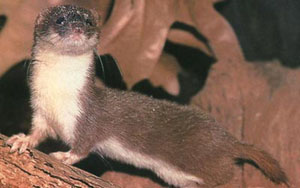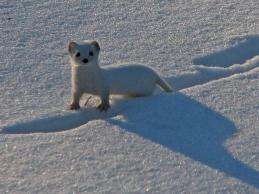Adaptation
The Least Weasel makes long term adaptations as well as short
term changes. One of the more recognizable adaptations
include fur coloration via molting.
The variations in fur color is dictated by the changing
seasons. They are also capable of turning a cinnamon or straw color to blend into
semi-dessert regions.
Molting allows for this adaptation. During molting the weasel sheds the current layer of fur and slowly changes to a color that fits the environment. This adaptation makes these organisms successful predators especially with their ability to blend into the pure white snow! Check out the drastic difference in fur colors below.


Summer- Dark Brown with White Stomach

 Winter-
White with black tipped tail
Winter-
White with black tipped tail
Mustela nivalis is known to have the brown color dominate the
dorsal side of the body, while the stomach, anterior region, is
coated with white fur. Adult weasels look dramatically different
than their lightly haired newborns.
You may be assuming that weasels hibernate like bears but they
don't. This is not a survival adaptation because their hair has an
outer shiny coat. This prevents wet substances (rain) from
adhering to the fur. The short layer underneath the protective
shiny layer, provides warmth. This advanced layer of fur
provides warmth and keeps them dry during rainy seasons and
winter months. This gives them an advantage over available prey
items while their neighbors are hibernating or seeking shelter from
the rain. Although they do have this well adapted fur, they do get
cold. In order to stay warm Mustela nivalis curls up in a
ball to conserve its body heat.
 Follow the weasel to its favorite meal, it sure is getting hungry...
Follow the weasel to its favorite meal, it sure is getting hungry...
